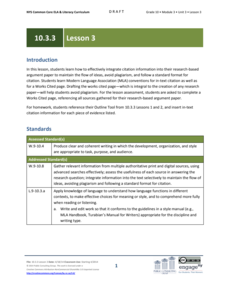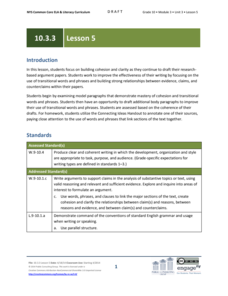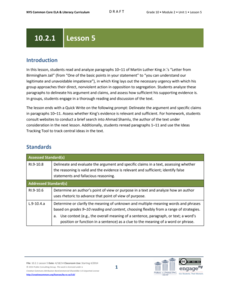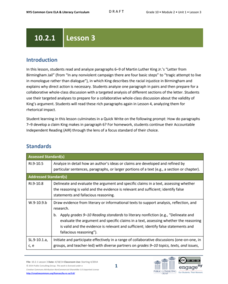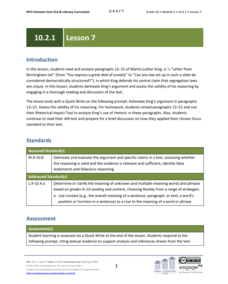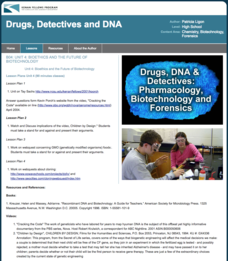EngageNY
Grade 11 ELA Module 2: Unit 1, Lesson 25
While preparing for the end-of-unit assessment, scholars look at Washington's "Atlanta Compromise" speech and identify the terms he used in the argument. They also identify the relationship between the claims presented in the speech and...
EngageNY
Grade 11 ELA Module 2: Unit 1, Lesson 24
You can never be too prepared. Scholars begin preparing for the end-of-the-unit assessment of Du Bois’s "Of Our Spiritual Strivings" and Washington’s "Atlanta Compromise" speech. They use peer discussion to discuss the relationship...
Literacy Design Collaborative
Rhetorical Analysis of Frederick Douglass
Is the Fourth of July a celebration for all Americans? Scholars carry out a close read of What to the Slave is the Fourth of July? Readers talk with partners about the speaker's point of view, the author's debate, reasoning, and...
Literacy Design Collaborative
The Sunflower: The Possibilities and Limitations of Forgiveness
After reading Simon Wiesenthal's The Sunflower, pupils form opinions either for or against forgiveness as well as analyze Wiesenthal's choice about forgiving. Before completing their essays, learners participate in class discussions to...
EngageNY
Grade 10 ELA Module 3: Unit 3, Lesson 11
It's time to show what you know. Scholars finalize their argumentative essays by making last-minute revisions to conventions, tone, and formal style. Learners review the checklist to ensure they have met all the task requirements. They...
EngageNY
Grade 10 ELA Module 3: Unit 3, Lesson 4
Always try to make an excellent first impression. As scholars begin to write their argumentative essays, they learn the importance of a good introduction. Writers also begin to add in-text citations to their papers. After reading a model...
EngageNY
Grade 10 ELA Module 3: Unit 3, Lesson 3
Who said that? Scholars now learn how to cite evidence, give ideas proper credit, and work to understand the meaning of plagiarism. Part of the activity includes looking at an MLA Citation handbook, handy when pupils create their works...
EngageNY
Grade 10 ELA Module 3: Unit 3, Lesson 2
Put yourself in my shoes! Scholars work through the Outline Tool from the previous lesson plan to develop a claim before developing a counterclaim about selling human tissue. Learners also create supporting claims using an outline tool....
EngageNY
Grade 10 ELA Module 3: Unit 3, Lesson 1
Human tissue for sale or rent? Scholars refer back to articles they read in the previous unit and make a claim as to whether they believe it's okay to sell human tissue. Learners talk with partners, complete an outline tool, and collect...
EngageNY
Grade 10 ELA Module 3: Unit 3, Lesson 5
Can you please clarify? Scholars continue to work on their argumentative essays about selling human tissue by clarifying and adding cohesion. Writers begin by looking at model paragraphs and then begin improving their writing. They...
EngageNY
Grade 10 ELA Module 3: Unit 2, Lesson 5
Have you ever argued for the sake of argument? Scholars dig into what makes a compelling argument. They learn to create evidence-based arguments using a teacher-led model. Once finished, they use an evidence-based checklist to guide...
National Endowment for the Humanities
The Declaration of Independence in Six Parts
Everyone knows that the Declaration of Independence is important, but what does it actually say? Members of American history classes analyze the Founding Fathers' arguments against British tyranny and for a more perfect union with a...
EngageNY
Grade 10 ELA Module 2: Unit 3, Lesson 2
Is good good enough? Scholars examine claims made in a speech by Elanor Roosevelt. Roosevelt claims that people should adopt the Universal Declaration of Human Rights because it is a good document. Readers discuss their ideas in pairs,...
EngageNY
Grade 10 ELA Module 2: Unit 3, Lesson 3
What is in a word? Scholars look closely at the words from a speech by Eleanor Roosevelt. They analyze how she supports a claim without debate and without rejecting others. Learners use jigsaw discussion, guided questions, and respond to...
EngageNY
Grade 10 ELA Module 2: Unit 1, Lesson 9
How did Martin Luther King Jr. establish tone in his writing? Scholars analyze King's tone and discuss how he changes and refines his claim in "Letter from Birmingham Jail." They also define new vocabulary words, respond to a writing...
EngageNY
Grade 10 ELA Module 2: Unit 1, Lesson 5
People should always choose their words carefully. Scholars examine the words used by Martin Luther King, Jr. in paragraphs 10 and 11 of his "Letter from Birmingham Jail." Readers answer questions about word use, think about synonyms,...
EngageNY
Grade 10 ELA Module 2: Unit 1, Lesson 3
What are the four basic steps of any nonviolent campaign? Readers discover the answer by analyzing a letter written by Martin Luther King Jr. Lesson three involves discussion and analysis of King's claims in paragraphs seven through...
EngageNY
Grade 10 ELA Module 2: Unit 1, Lesson 12
Sticks and stones may break bones, but words matter. Scholars analyze words in paragraphs from Martin Luther King Jr.'s "Letter from Birmingham Jail." They use new vocabulary words and discuss how King's words develop and support his...
EngageNY
Grade 10 ELA Module 2: Unit 1, Lesson 7
Scholars read King's "Letter from Birmingham Jail" paragraphs to identify his arguments and reasoning. They discuss their ideas in pairs and small groups, complete a Model Argument Delineation Tool, and respond to a quick writing prompt.
Aurora City School District
Do Not Try to Kid a Kidder: The Art of Persuasion
The power to convince others of your argument lies in your knowledge of rhetoric! A thorough packet covers the basics of persuasion, including logical appeals and fallacies, and applies strategies to letters to the editor,...
Read Write Think
Persuasive Techniques in Advertising
Ever wonder if that miracle product in the commercial is really a miracle? Chances are, the only miraculous part is how many people the advertisers are able to convince to buy it! Class members look over short descriptions of techniques...
California Department of Education
Me and My Career
Your career search starts here! Sixth grade scholars begin their journey toward college and career readiness in the first of a five-part series of lessons. Individuals identify where their interests lead them using the Holland code, then...
The Holler
Conflict Resolution
Does your class understand the importance of peaceful conflict resolution? Middle schoolers share conflict stories, then collaborate to resolve simulated conflicts during an engaging lesson plan. The teacher's guide contains...
Kenan Fellows
Unit 4: Bioethics and the Future of Biotechnology
What's the future of biotechnology? Explore a hot topic in the fourth and final unit in a series of Biotechnology lessons. Learners develop an understanding of the many issues in bioethics, then create an argument for or against the role...








